Living in a small shared bedroom can be a fun and creative challenge that sparks some of the most clever design ideas! As families look for ways to maximize space without sacrificing comfort or style, small shared bedroom ideas have become more popular than ever. They offer a chance to turn tiny spaces into cozy, functional havens where siblings can thrive, bond, and grow together.
In this article, you’ll discover a variety of innovative and practical ideas to transform a compact shared bedroom into a harmonious retreat. From clever storage solutions to space-saving furniture and personalized zones, these tips will inspire you to make the most of limited space while creating a welcoming environment for every sibling. Get ready to unlock your bedroom’s full potential and foster sibling harmony with these creative ideas!
1. Vertical Space Utilization with Lofted Beds for Compact Comfort
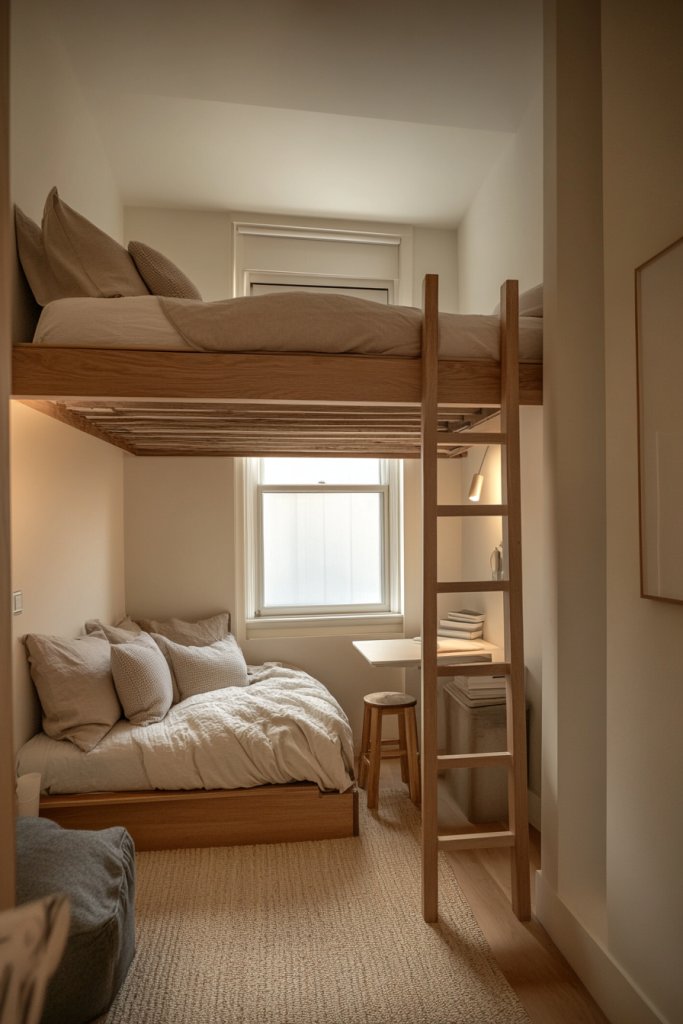
Living in a small shared bedroom can feel like trying to squeeze into a closet—cramped, cluttered, and lacking privacy. Siblings often struggle to carve out personal space without stepping on each other’s toes. The desire for more room and personal sanctuary seems out of reach, but what if you could reclaim that precious square footage?
Imagine a cozy loft bed painted in cheerful pastel hues, with a soft cream throw blanket draped over the edge. Beneath it, a dedicated play corner with a plush rug and a small desk tucked into the alcove. Natural light streams through a window, highlighting the layered textures of textiles and the clever use of space. It’s a clever, multi-level setup that makes the room feel larger and more inviting.
Loft beds come in various styles—industrial metal frames for a modern vibe or wooden ones for warmth and charm. You can customize with different color paints or add personal touches like decals or fabric drapes. For smaller rooms, a low-profile loft preserves ceiling height, while in larger spaces, multi-tiered arrangements can separate zones further. Seasonal accessories like cozy throws or decorative pillows can refresh the look anytime.
Start by measuring your space and choosing a sturdy loft bed that fits your room dimensions. Secure the bed to the wall if necessary for extra stability. Use under-bed space for a small desk, storage drawers, or even a reading nook. Install safety rails and ensure the ladder is sturdy and easy to climb. Add soft lighting underneath or on the bed frame for a cozy glow without bulky lamps, and keep the area clutter-free with wall-mounted shelves or bins.
Personalize with hanging fabric banners or string lights along the bed frame. Use colorful textiles for bedding, and add a small chalkboard or corkboard on the side for notes and artwork. Incorporate themed accessories matching each sibling’s interests—like sports, animals, or favorite colors—to foster ownership. Small plushies or decorative pillows can add a touch of personality and comfort.
Lofted beds are a game-changer for maximizing small rooms and giving kids their own space. They boost comfort and help foster independence and organization. Plus, they look super cool and modern, inspiring kids to take pride in their personal sanctuary. Ready to rethink your room layout and make every inch count?
2. Customizable Wall-Mounted Storage Solutions for Clutter-Free Shelving
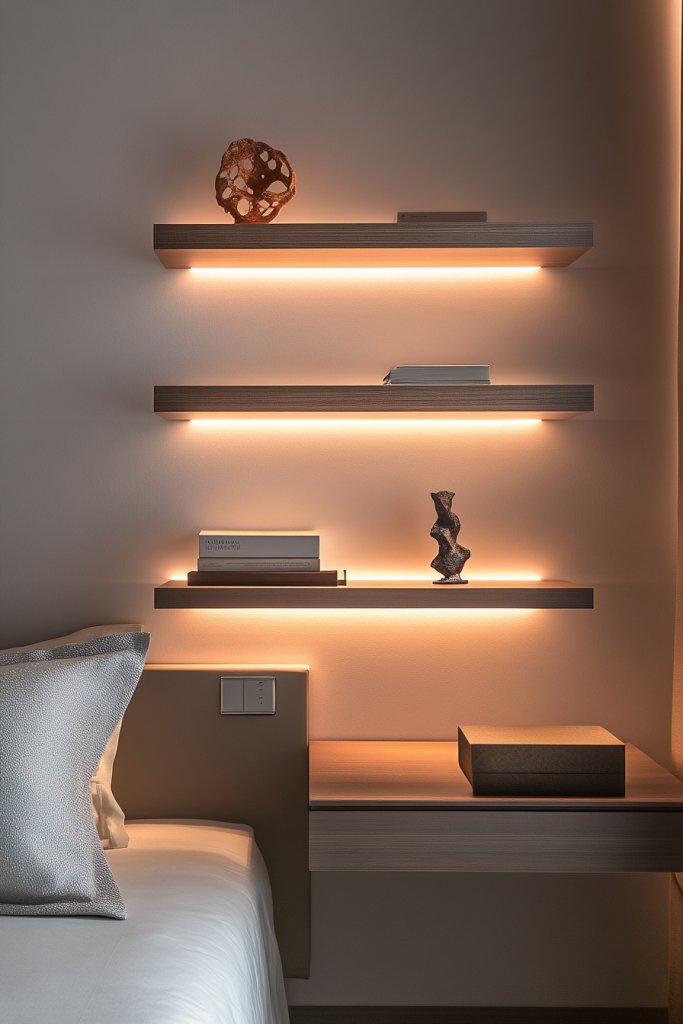
Clutter in small shared bedrooms is the enemy of peace and productivity. Stuff tends to pile up, making the room look chaotic and leaving little room to breathe. Wouldn’t it be fantastic if everything had its place and was just within reach?
Envision a wall lined with sleek, modular cubbies painted in cheerful colors, each holding toys, books, or school supplies. Pegboards with hooks display accessories and essentials, while baskets tucked into wall-mounted shelves hide miscellaneous items. The room looks tidy, vibrant, and inviting—every item has a designated spot, and surfaces are kept clear. It’s a perfect example of how vertical storage can transform chaos into calm.
Choose open shelving for easy access or closed cabinets for a clean look. Use bright colors or neutral finishes depending on the room’s aesthetic. For smaller rooms, vertical storage maximizes space without sacrificing floor area. Incorporate magnetic strips or small hooks for jewelry, accessories, or notes. Seasonal or thematic accessories can be swapped easily to keep things fresh.
Start by assessing what items need organizing and measuring available wall space. Install sturdy wall anchors and brackets suited for the weight of your chosen shelving units. Use a level for precise mounting, and plan placement to avoid obstructing windows or outlets. Use bins, baskets, or small jars on shelves to contain smaller items. Label each container for quick identification, and periodically declutter to maintain order.
Decorate shelves with themed storage bins, decorative labels, or colorful fabric liners. Use adhesive hooks for hanging small items or accessories. You can also add framed photos or motivational quotes on the wall near the storage to personalize further without cluttering surfaces. Mix textures like wood, metal, or fabric for visual interest.
Customizable wall-mounted storage keeps everything within reach and helps kids develop organizational habits early. It makes tidying up a quick and easy task, reducing stress and arguments. Plus, a neat room boosts confidence and encourages responsibility. Who knew that a simple shelf could be a game-changer?
3. Shared Desk Area with Divided Workspaces for Focused Study Time
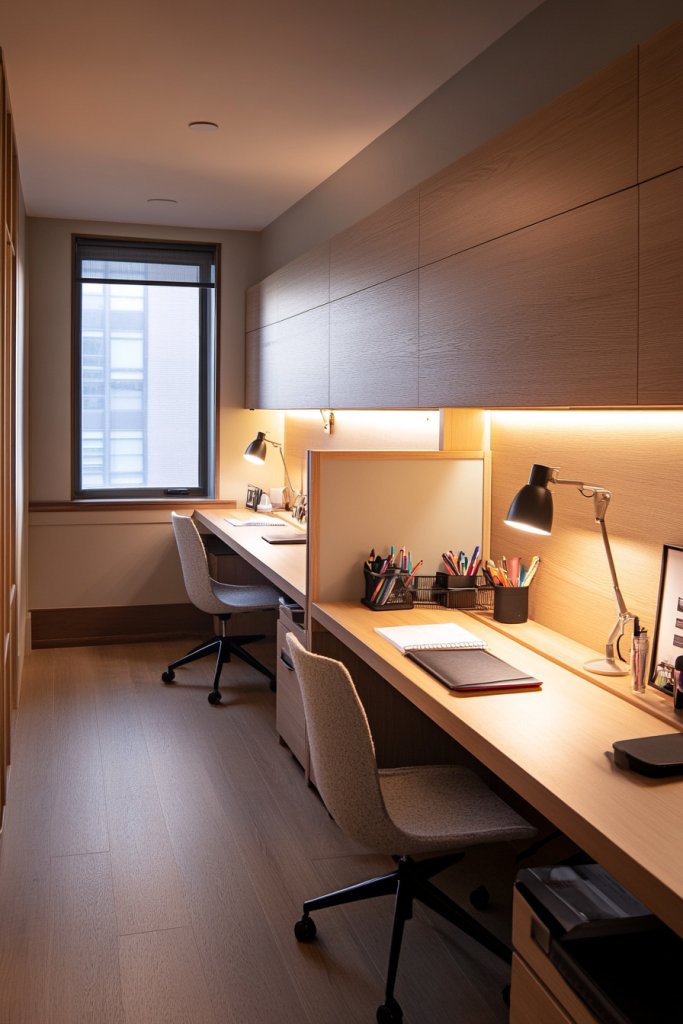
When siblings share a bedroom, studying or working on projects can turn into a competition or distraction fest. Finding a quiet, focused area for each can feel impossible without dedicated space. Wouldn’t it be great if they could each have their own zone for homework and creativity?
Picture a long, shared desk with a fabric divider running down the middle—each side personalized with different colors or patterns. One sibling’s side is stacked with notebooks, art supplies, and a small lamp, while the other’s is neat and minimalist, with a calendar and a few pens. The space feels organized, private, and conducive to concentration. The room buzzes with a sense of calm focus, despite sharing proximity.
Use foldable or extendable desks to fit different room sizes or needs. Privacy can be enhanced with fabric or acrylic partitions, or even decorative screens. For older kids, add adjustable monitor stands or ergonomic accessories. Incorporate storage solutions under or beside the desk for supplies, ensuring each sibling’s area stays clutter-free. For smaller rooms, wall-mounted fold-down desks save space when not in use.
Measure the available wall or floor space to select an appropriately sized desk. Divide the workspace with a curtain, fabric panel, or lightweight partition that can be easily moved or cleaned. Use clip-on lamps or LED strips on each side for personalized lighting. Organize supplies in small containers or wall-mounted holders to keep everything tidy. Encourage each sibling to maintain their space and respect boundaries.
Personalize each side with name plaques, favorite colors, or themed accessories. Use corkboards, whiteboards, or small shelves for individual storage or display items. Incorporate flexible elements like magnetic strips for notes or art. Add a small plant or decorative item on each side to bring personality without clutter.
Creating dedicated study zones helps kids focus, reduces conflict, and builds responsibility. It teaches valuable habits like organization and respecting personal space. Plus, a well-designed workspace can motivate kids to do better academically and creatively. Everyone wins when each sibling has their own focused corner.
4. Multi-Functional Furniture: Beds with Built-In Drawers and Desks
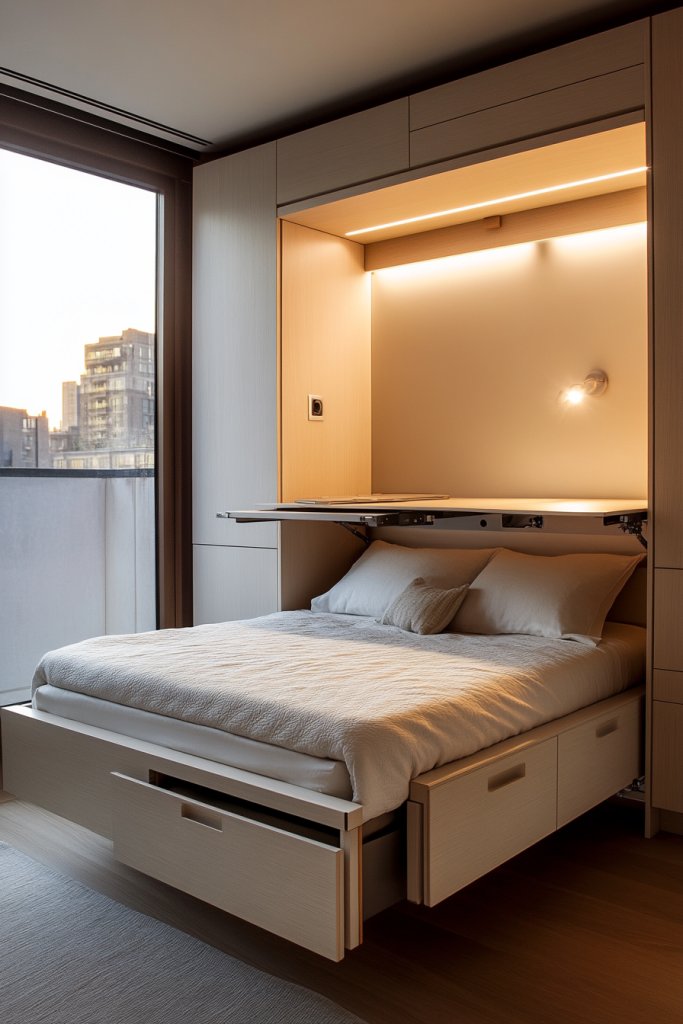
Small bedrooms often mean sacrificing storage or workspace, leaving the room feeling cluttered and chaotic. The struggle is real: where do you put all the clothes, books, and school supplies? Wouldn’t it be awesome if your furniture could do double duty?
Imagine a sleek bed frame with drawers built into the base, neatly storing clothes or toys. Next to it, a fold-out desk with compartments for pens and papers, all seamlessly integrated into the design. The furniture in warm wood tones or modern metal finishes blends function with style, creating a clutter-free zone that still feels cozy. It’s like having a mini home office and wardrobe all in one compact piece.
Choose furniture with adjustable or modular features to grow with your child. For younger kids, lower beds with accessible storage work well; for teens, lofted beds with study nooks underneath are perfect. Select finishes and hardware that match your decor theme—minimalist, rustic, or playful. Incorporate additional storage solutions like wall-mounted shelves or hanging organizers for extra efficiency. These pieces work in various room sizes, maximizing every inch.
Start by selecting a sturdy bed frame with ample drawers or built-in compartments. Measure your space carefully to ensure enough clearance for opening drawers and using the desk. Assemble the furniture following manufacturer instructions, paying attention to weight limits and stability. Place the bed against a wall to free up floor space, and position the desk nearby for convenience. Organize small items in labeled bins or drawer dividers, and add a comfortable chair for study sessions.
Add decorative knobs or stickers to drawers for a pop of color or personality. Use fabric or cushioned covers on the bed to enhance comfort. Personalize the desk area with motivational quotes or a custom nameplate. Incorporate small, decorative storage baskets for books or supplies, keeping everything within easy reach. Changing the accessories seasonally keeps the space engaging.
Multi-functional furniture makes tiny rooms feel spacious and organized. It teaches kids to value practical design and responsibility for their space. Plus, it simplifies cleaning and tidying, reducing stress. With the right pieces, your child can enjoy a stylish, clutter-free retreat that adapts as they grow.
5. Adjustable Divider Curtains for Temporary Privacy and Flexibility

Sharing a room means sharing everything—space, privacy, and sometimes even sleep. When one sibling needs quiet study time or a quick nap, the lack of privacy can cause tension. Wouldn’t it be great if there was a quick, easy way to carve out personal zones on demand?
Imagine lightweight fabric curtains in cheerful patterns or calming neutrals hanging from ceiling tracks, easily pulled across when needed. When open, the room feels spacious and connected; when closed, it transforms into two private retreats. Soft textures and flowing fabrics create a cozy, flexible barrier that subtly defines personal space without permanent changes. The room feels adaptable, welcoming, and clutter-free.
Choose sheer or opaque fabrics depending on privacy needs. Install ceiling-mounted tracks or tension rods for easy setup and removal. Use colors and patterns that complement the room’s decor—bright and playful for kids, or neutral for teens. For added style, layer curtains with different textures or add decorative tiebacks. This flexible solution suits various room sizes and personal preferences.
Measure the area where you want the curtain to hang and install sturdy ceiling tracks or tension rods. Select fabrics that are easy to clean and durable for frequent use. Attach hooks or rings for smooth opening and closing. Keep the curtains lightweight for easy movement, and coordinate colors with the room’s decor. When privacy is no longer needed, simply pull the curtains aside and secure them neatly. Maintenance involves regular washing or spot cleaning.
Add decorative elements like tassels, trim, or personalized patches to the curtains. Use different fabrics or layered curtains for a more dynamic look. For special occasions, switch to themed fabrics or seasonal colors. Hang small accessories like charms or fabric flowers to give each sibling’s curtain a unique touch. These curtains can evolve with changing tastes or moods.
Adjustable curtains offer flexibility and quick privacy, reducing conflicts and helping kids feel secure. They teach responsibility in managing personal space and respecting others’ needs. Plus, they’re a budget-friendly way to add style and functionality. With a simple pull, your room transforms into a multi-use space—perfect for busy households.
6. Incorporation of Creative Headboards with Personal Touches
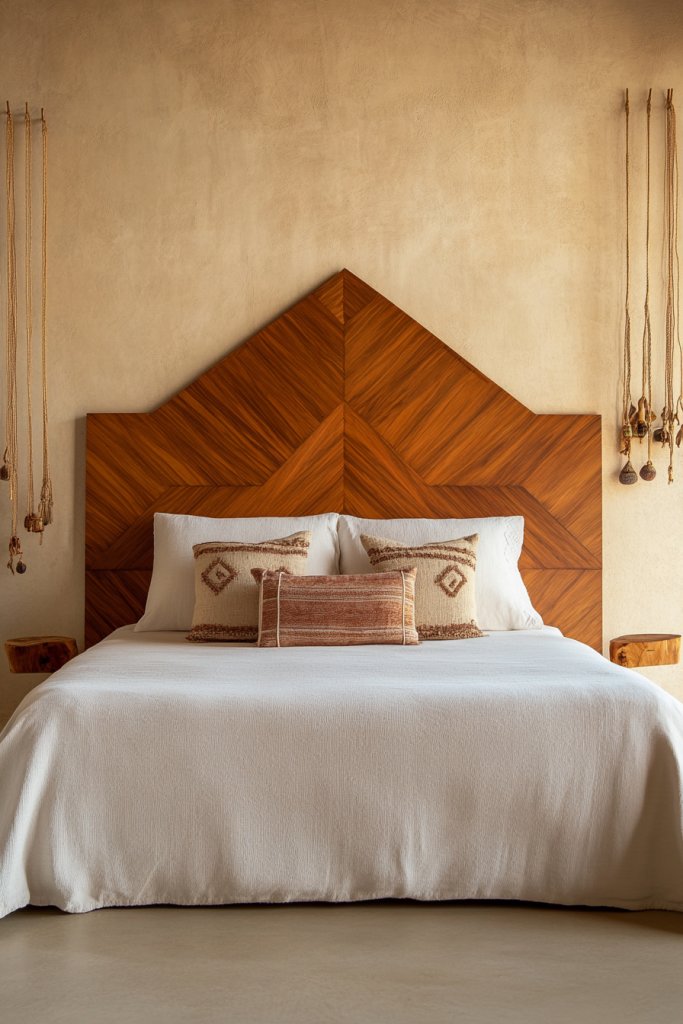
A plain bed can feel uninspired, especially in a shared bedroom where each sibling craves a touch of personality. Without a headboard, the bed looks unfinished, and the space lacks character. Wouldn’t it be wonderful if the head of the bed could double as a personalized statement piece?
Visualize a DIY fabric-covered headboard decorated with colorful decals, or a painted wooden panel with carved initials and motifs. Small hooks or pockets are incorporated for hanging accessories or storing bedtime essentials. Textured fabrics, fun shapes, or even a corkboard surface turn the headboard into both decor and a functional organizer. It transforms a basic bed into a personalized retreat filled with personality.
Create headboards from reclaimed wood for rustic charm or upholstered foam for comfort and softness. Use removable fabric covers in favorite colors or patterns for easy updates. For a modern look, geometric shapes or metallic finishes work well. Incorporate hooks, small shelves, or fabric pockets into the design for extra storage. Tailor the size and style to match each sibling’s taste and room decor.
Start by choosing a style that fits your decor and skill level—DIY projects are budget-friendly and customizable. Measure your bed’s width and height, then cut materials accordingly. Attach fabric, wood, or upholstery with staples, nails, or adhesive, ensuring a smooth finish. Add small hooks or pockets for accessories, and decorate with decals, paint, or fabric embellishments. Secure the headboard firmly to the bed frame or wall for safety.
Personalize with a name or favorite quote painted or stitched onto the headboard. Use themed fabrics or colors that reflect each sibling’s personality. Add decorative elements like fabric flowers, buttons, or small mirrors for extra flair. Rotate accessories seasonally or for special occasions to keep the look fresh and engaging.
Creative headboards turn a basic bed into a personal sanctuary that sparks joy and pride. They encourage kids to express themselves and take ownership of their space. Plus, a unique headboard can be a great conversation starter and a source of inspiration for DIY projects. Your bedroom just got a whole lot more personal—and fun!
7. Bright, Coordinated Storage Bins for Easy Access and Organization

Clutter piles up fast in shared bedrooms, turning tidy into chaos in no time. With multiple kids sharing limited space, finding a system that’s both accessible and neat can seem impossible. Wouldn’t it be fantastic if storage was both functional and colorful enough to inspire tidiness?
Picture a row of matching storage bins in cheerful hues—lime green, sky blue, and soft pink—lined up under the beds or on shelves. Each bin is labeled with clear, bold text or fun icons so kids can easily find and put away their belongings. The vibrant colors brighten the room, while uniformity keeps the space looking organized and inviting. It’s a simple yet effective way to make tidying up fun.
Select bins in different sizes to accommodate various items—clothes, toys, books, or art supplies. Use stackable bins or baskets with handles for easy transport. For a playful look, choose bins with patterns or cartoon motifs; for a minimalist aesthetic, go for solid colors and sleek designs. Incorporate transparent containers for quick identification of contents. Rotate colors seasonally or for different storage needs.
Start by assessing storage needs and measuring available space. Choose bins with secure lids or open tops depending on accessibility. Label each bin with clear, waterproof labels or use decorative tags for a personalized touch. Stack or line up the bins in strategic spots—under beds, on shelves, or inside closets. Encourage kids to maintain the system by regularly sorting and decluttering. Keep the area around the bins tidy to reinforce good habits.
Decorate labels with stickers or handwriting for a personal touch. Use themed bins matching room decor or favorite characters for added fun. Incorporate small decorative elements like bows, patches, or fabric overlays. Mix in a few special, decorative storage pieces for fragile or sentimental items. Using a variety of textures and styles keeps the system engaging and adaptable.
Bright, coordinated bins make organization easy and encouraging for kids. They foster independence by enabling quick cleanup and retrieval of belongings. Plus, a tidy room boosts mood, productivity, and confidence. When storage is visually appealing and straightforward, maintaining order becomes second nature. It’s a small change with a big positive impact.
8. Minimalist Floating Shelves for Decorative and Practical Items
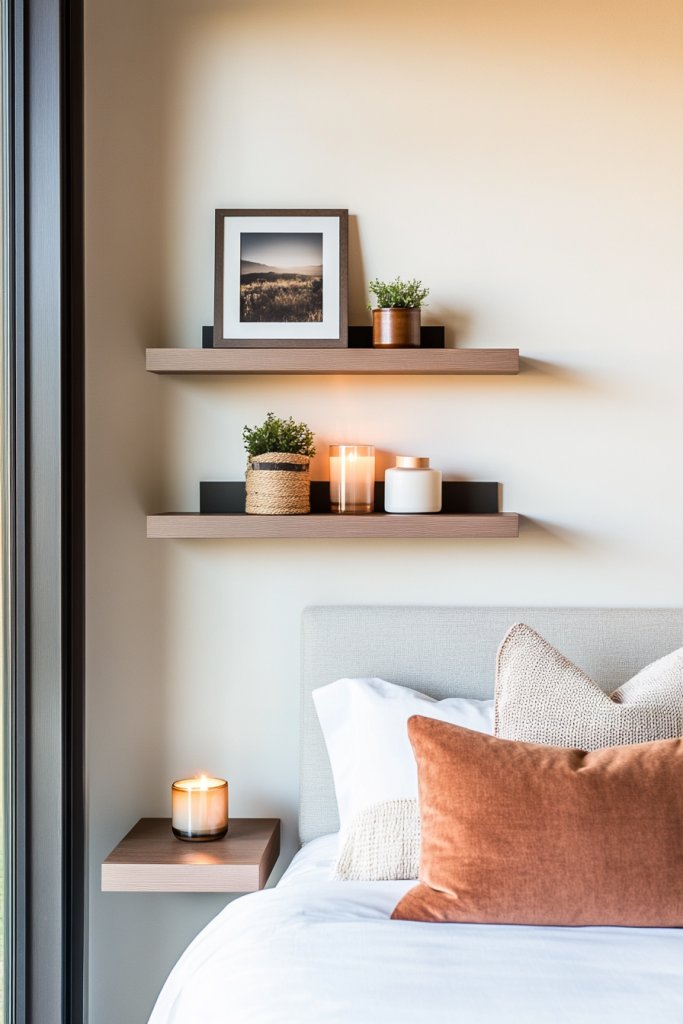
Overstuffed shelves and cluttered surfaces can make a small room feel even tighter and more chaotic. Finding a way to display essentials and personal items without overwhelming the space is tricky. Wouldn’t it be nice if your storage and display could be sleek, simple, and almost invisible?
Visualize a set of thin, white floating shelves mounted along the wall, holding neatly stacked books, small decorative boxes, and a few personal mementos. The clean lines and lack of visible brackets create an airy, uncluttered look. Soft lighting from behind or above adds warmth without bulk. The space looks organized, modern, and inviting—perfect for showcasing what matters most.
Choose floating shelves in different lengths and thicknesses depending on what you want to display. Use neutral colors for a minimalist vibe or bold hues for a pop of color. Mix and match shelf styles for visual interest, or keep it uniform for a more cohesive look. Incorporate small decorative elements like woven baskets or decorative jars to contain smaller items. Adjust shelf placement over beds, desks, or empty wall spaces.
Measure the wall space carefully and select sturdy, wall-mountable shelves suitable for your items. Install brackets or hidden mounting hardware for a seamless appearance—use a level to ensure perfect alignment. Arrange your items thoughtfully, balancing height, color, and size. Use small containers or baskets on the shelves to keep tiny items organized. Regularly dust and tidy shelves to maintain that sleek look.
Decorate shelves with themed or seasonal items—like a small sculpture, a favorite mug, or a decorative box. Use washi tape or stickers to add flair to plain containers. Personal photos or small framed quotes can add a personal touch without cluttering surfaces. Rotate items seasonally or for special occasions to keep the display fresh and engaging.
Floating shelves provide a clutter-free way to showcase personal style and organize essentials. They help keep surfaces clear and the room feeling spacious. Kids learn to curate their display, fostering pride and responsibility. A tidy, curated space boosts mood and creativity. Less clutter, more calm—that’s the magic of floating shelves.
9. Personalized Name Plates or Monogram Decor for Each Sibling
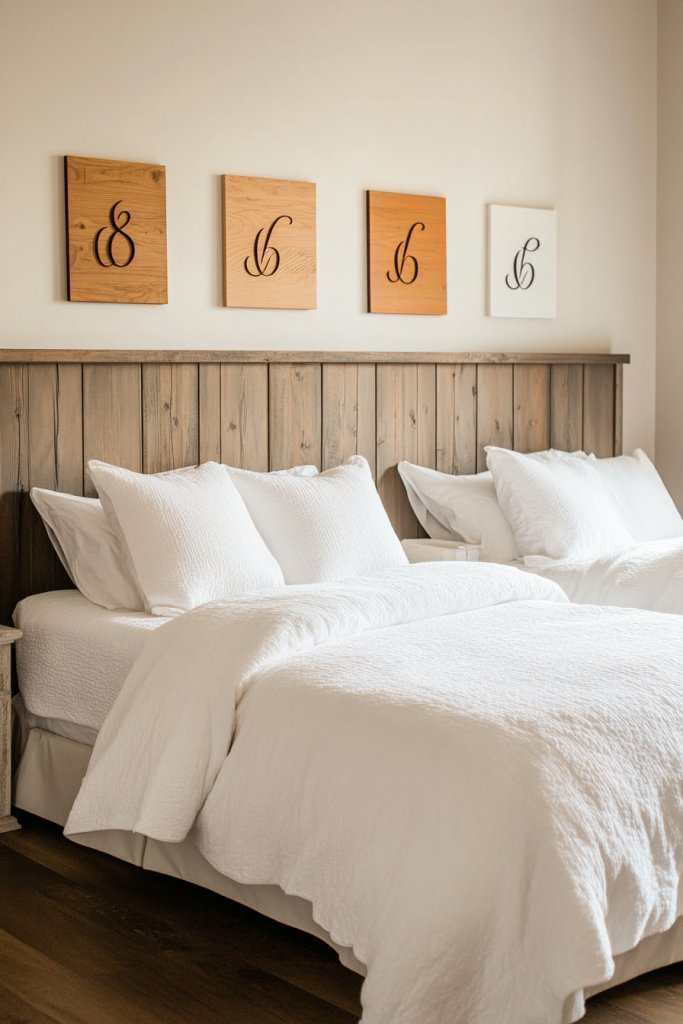
A shared bedroom can sometimes feel like a generic space where everyone’s identity gets lost. Kids crave recognition and a sense of ownership over their space. Wouldn’t it be wonderful if a simple, personalized touch could make their corner unmistakably theirs?
Imagine sleek wood or acrylic nameplates with each sibling’s initials mounted above their bed or on their storage cubbies. Monogrammed wall decals in fun fonts add a playful yet elegant touch. The personalized decor instantly creates a sense of pride and belonging. Bright colors or metallic finishes make the initials pop against the wall, transforming the room into a personalized sanctuary.
Use different materials—wood, acrylic, metal—for variety and durability. Incorporate themes or motifs that reflect each sibling’s personality, like stars, animals, or favorite colors. Change the design seasonally or as tastes evolve. For a DIY project, kids can decorate their own initials with paints, stickers, or washi tape. Keep the placement consistent for visual balance or vary it for an eclectic look.
Select or create the initials or nameplates based on preferred style and size. Mount them securely above the bed, desk, or closet area using appropriate hardware. Use a level to ensure straight placement, and choose a spot that’s visible but not intrusive. For a cohesive look, coordinate the style of nameplates with other decor elements. Regularly clean and update as tastes or names change.
Encourage kids to decorate their own nameplates with paint, stickers, or embellishments. Add small decorative elements like tiny pom-poms, glitter, or LED accents for extra flair. Incorporate their favorite symbols or icons alongside the initials. Rotate or update the nameplates to reflect changing interests or milestones.
Personalized name plates reinforce a child’s sense of identity and pride in their space. They help foster independence and respect among siblings. Plus, they add a charming, personal touch that makes the room uniquely theirs. With a little creativity, a simple monogram can become a cherished part of their personal sanctuary.
10. Multi-Level Hanging Organizers for Shoes and Accessories
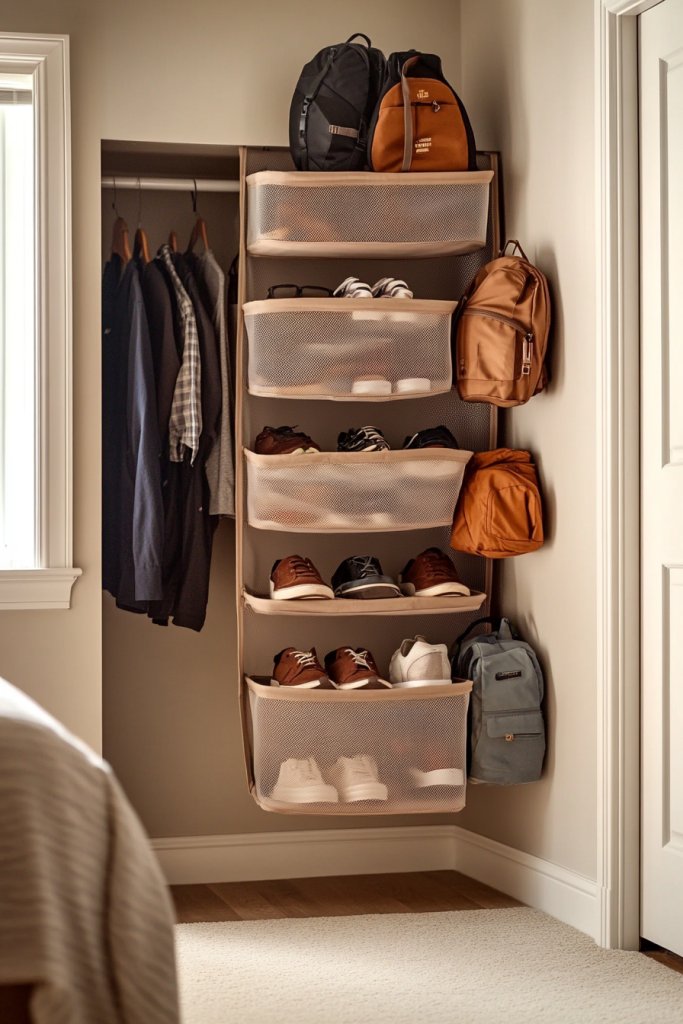
Shoes, backpacks, and accessories tend to clutter floors and closets in shared bedrooms, making the space look messy and feel cramped. Finding a practical, space-saving way to organize these items can be a challenge. Wouldn’t it be great if everything had a designated spot, easily accessible?
Picture a multi-pocket hanging organizer on the back of a door, with each pocket filled with shoes, jewelry, or small accessories. The clear, fabric compartments keep everything visible at a glance, saving time and fuss. Colorful, coordinated organizers add a cheerful touch, turning clutter into order. The room instantly looks more spacious, with each item neatly stored and ready to grab.
Choose from fabric, mesh, or waterproof plastic materials depending on your needs. Use multi-tiered hanging pockets for shoes, or dedicate a section for accessories. Hang organizers on closet doors, hooks, or wall-mounted rods for flexibility. For older kids, label each pocket with their name or icon. Rotate or switch out organizers seasonally for variety.
Identify high-traffic areas like behind doors or near closets for hanging. Securely attach hooks or rods that can support the weight of the organizer. Fill the pockets with shoes, jewelry, or small items—keeping similar items together for ease of use. Encourage kids to put items away after use, fostering responsibility. Regularly check and declutter to keep everything tidy.
Decorate pockets with fabric paint or stickers to reflect each sibling’s personality. Use different colors or themes to distinguish their sections. Add small charms or clips for hanging keychains or hair accessories. Encourage kids to customize their organizer with drawings or labels—making organization fun and personal.
Multi-level hanging organizers teach kids responsibility and organization skills early on. They help keep the room tidy and clutter-free, making daily routines smoother. Kids feel proud when they can find and put away their belongings easily. It’s a simple, effective way to foster independence and respect for shared spaces.
11. Themed Bedding and Decor for Cohesive Yet Distinct Personalities
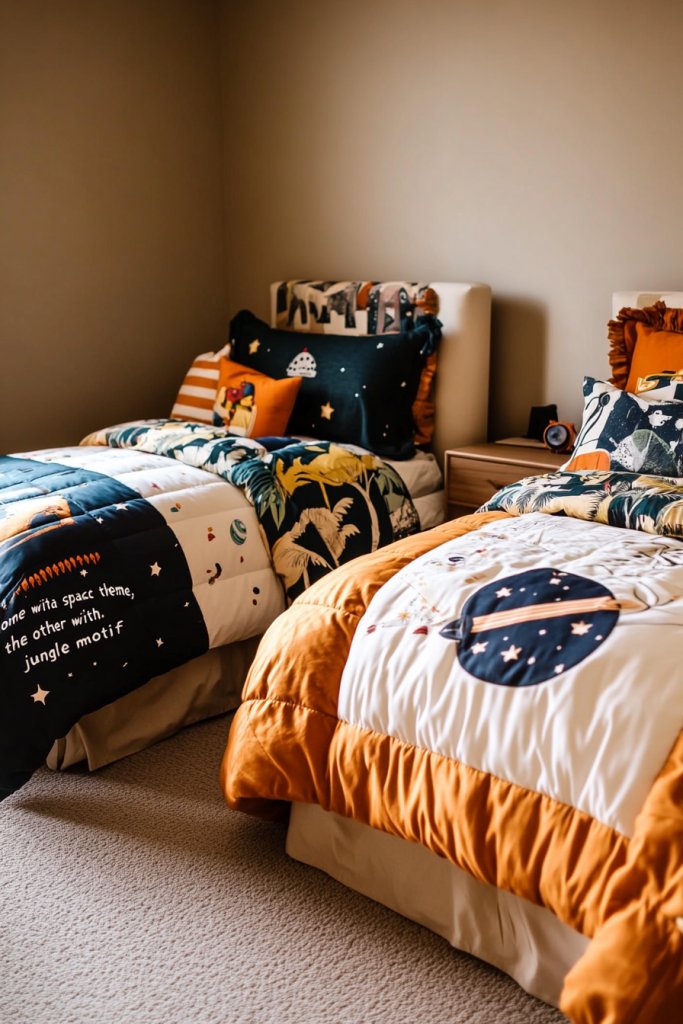
A shared bedroom often risks becoming a bland, uniform space that fails to reflect each child’s personality. Without a theme or distinctive decor, it’s hard for kids to feel truly at home. Wouldn’t it be fantastic if each sibling’s bed and space could tell its own story?
Imagine beds dressed in nautical stripes and marine motifs for one sibling, while the other’s features jungle animals in lively greens and browns. The room’s decor ties together with a common theme—like adventure, fantasy, or nature—but each bed has unique accents that showcase individual tastes. Small details like themed pillowcases, curtains, or wall decals complete the look, creating a harmonious yet personalized environment.
Select a unifying color palette or motif—such as geometric patterns, celestial themes, or favorite animals—and customize each bed with different prints or accessories. Mix textures like plush, cotton, or silk for variety. For seasonal updates, add themed throws or decorative pillows that reflect current interests. This approach makes the room feel lively and thoughtfully curated without feeling chaotic.
Choose bedding sets and decorative accents in line with the chosen themes. Use themed wall decals or removable wallpaper to reinforce the look without permanent changes. Incorporate matching or complementary colors in curtains, rugs, and storage bins. Personalize each bed with themed pillows or plushies that reflect their personality. Regular updates keep the decor fresh and engaging as interests evolve.
Encourage kids to add their own touches—like DIY pillowcases or wall art—within the theme. Use themed storage boxes or bins for toys and clothes, reinforcing the style. Incorporate favorite characters or motifs through DIY crafts or decals. Seasonal changes can include new bedding or accessories, keeping the space exciting and current.
Themed decor helps kids see their space as a reflection of themselves, boosting confidence and pride. It creates a harmonious environment that celebrates individuality while maintaining cohesion. When each bed feels personalized and special, the room becomes a source of inspiration and joy for everyone involved.
12. Creative Bed Niche or Alcove for a Cozy Personal Retreat
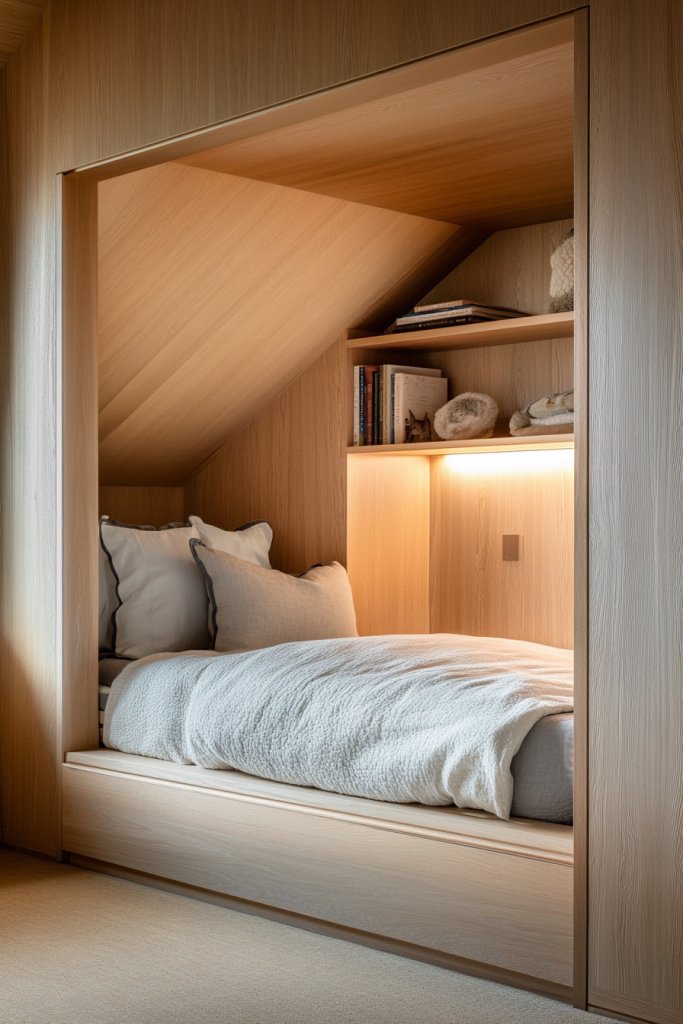
In shared bedrooms, finding a private corner for each kid can be tough. They often feel exposed or crowded, especially when they need a quiet space to relax or sleep. Wouldn’t it be amazing if each sibling had their own cozy nook within the room?
Imagine a small, built-in alcove with soft curtains and a plush mattress tucked inside, decorated with fairy lights and personalized pillows. The nook is shielded from the rest of the room, creating a private sanctuary. Warm textiles, gentle lighting, and personal touches make it inviting—a perfect retreat for reading, relaxing, or just escaping the chaos.
Build a simple framed niche into the wall or create a cozy corner with a canopy or tent fabric. Use soft, textured textiles for bedding and curtains to enhance comfort. For larger rooms, multiple alcoves can be arranged along a wall, each personalized with different themes or colors. Keep the space low-maintenance with easy-to-clean fabrics and simple decor.
Identify the best wall or corner for a niche, then build or retrofit a structure to enclose it. Add a cushioned mattress or floor pad inside, and hang curtains or fabric panels for privacy. Install soft lighting or string lights to create warmth. Decorate with pillows, small shelves, or wall decals that reflect each sibling’s personality. Regularly tidy and refresh the space to keep it cozy.
Personalize each nook with favorite colors, patterns, or themed accessories like plush toys or wall decals. Use small baskets or pockets inside for storing books or personal items. Incorporate a small shelf or ledge for bedtime essentials. Seasonal decor or new textiles keep these retreats fresh and inviting.
Creating a cozy alcove fosters independence, responsibility, and a sense of ownership. Kids feel special having their private space, which can reduce conflicts. It’s a simple, creative solution that makes the room feel like a collection of personal sanctuaries, inspiring confidence and comfort.
13. Colorful Wall Decals and Removable Wallpaper for Dynamic Decor
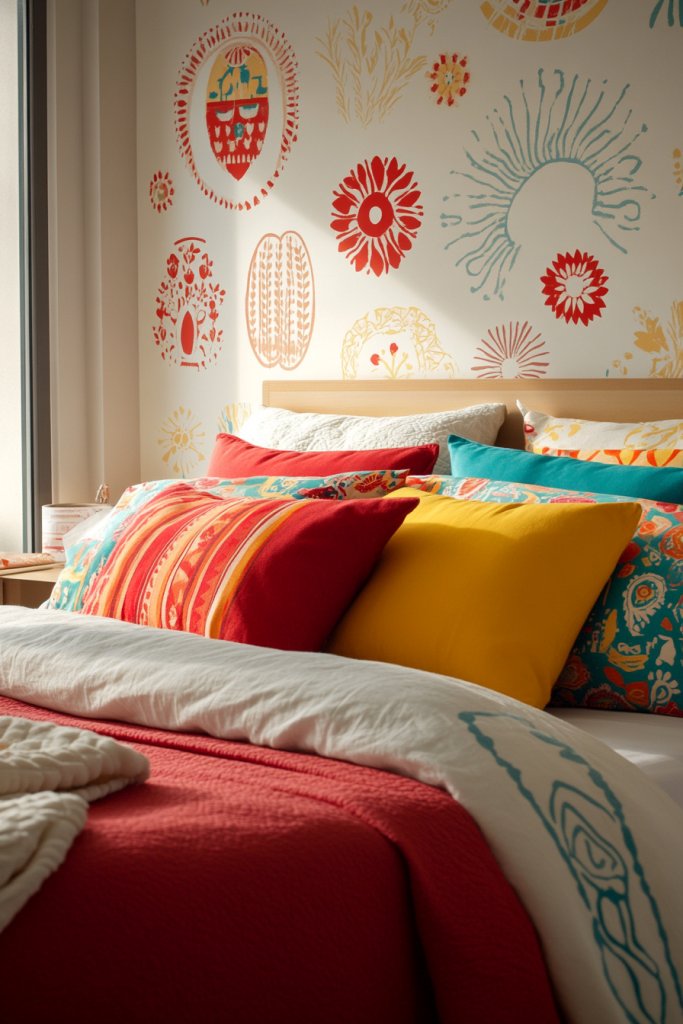
A bland, unchanging room can quickly become dull, especially in a shared space where personalization is limited. Permanent changes are often costly and hard to update as tastes evolve. Wouldn’t it be great if you could instantly refresh your room’s look without mess or commitment?
Imagine a wall adorned with removable wallpaper featuring playful geometric shapes or dreamy clouds in vibrant colors. Complemented by cheerful wall decals of animals, stars, or favorite characters, the room feels lively and personalized. Kids can move or peel off decals and wallpaper whenever they want, creating a space that reflects their current mood or interests. It’s a fun, easy way to add personality and energy.
Choose peel-and-stick wallpaper or decals in themes that suit your kids—nautical, jungle, space, or abstract. Use bold patterns for energetic spaces or soft pastels for a calming atmosphere. Mix and match different decals to create a collage or scene. For seasonal updates, swap out decals or add new sections of removable wallpaper. Compatibility with different wall textures makes this versatile.
Clean the wall thoroughly and plan your design layout. Carefully peel and stick wallpaper or decals, smoothing out bubbles as you go. Use a level or measuring tape for precise placement. For a balanced look, start from the center and work outward. When changing designs, gently peel off decals or wallpaper without damaging the wall. Keep extra decals or sections for future updates.
Create a DIY scene by combining decals with painted elements or fabric accents. Let kids choose their favorite themes and arrange decals creatively. Add small accessories like faux flowers or stars for extra flair. Use decals to frame or highlight specific areas, making the room feel dynamic and alive. Regular updates keep the decor fresh and engaging.
Dynamic decor encourages kids to express themselves and take ownership of their space. It makes changing the look easy and fun, fostering creativity and adaptability. A room that evolves with their tastes becomes a source of pride and happiness. No more permanent walls—just endless possibilities!
14. Incorporation of Under-Bed Storage Drawers for Extra Organization
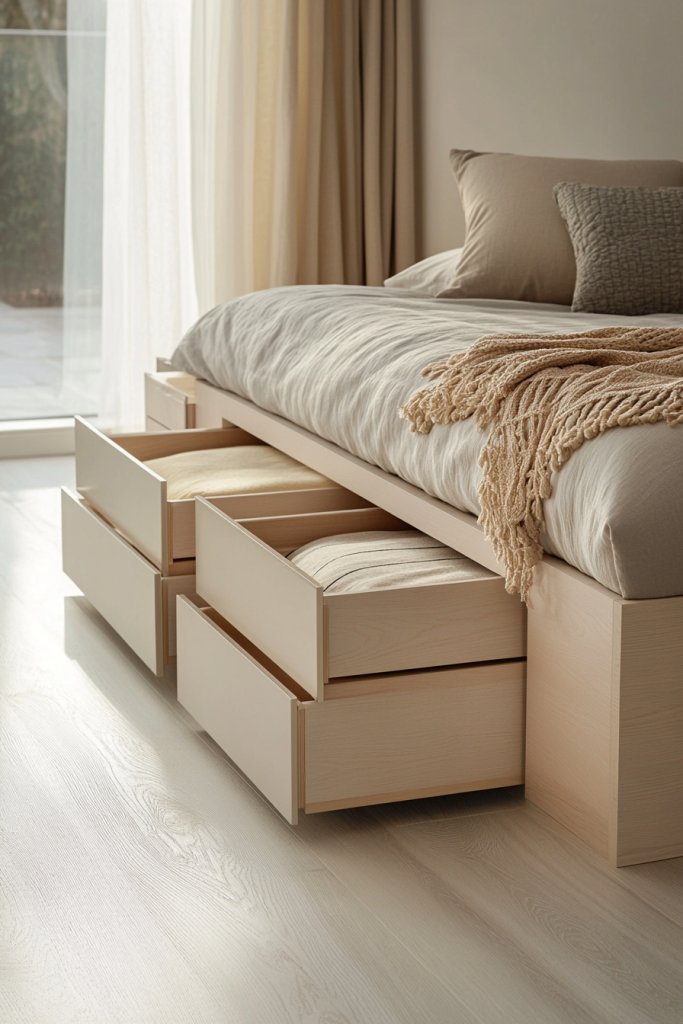
In small rooms, every inch counts—especially when it comes to storage. Under-bed space is often wasted or cluttered, turning into a catch-all for forgotten items. Wouldn’t it be fantastic if that hidden space could be turned into a neat, organized storage zone?
Picture sleek, rolling drawers neatly tucked under each bed, holding seasonal clothing, toys, or bedding. The drawers are in bright colors or neutral tones, blending seamlessly with the room’s decor. When needed, they slide out smoothly, revealing a tidy, accessible space that keeps clutter out of sight. The room looks cleaner, larger, and more organized—like a miracle in a small space.
Choose from plastic bins, wooden drawers, or fabric-wrapped containers depending on your style and budget. For a more built-in look, custom cabinetry or platform beds with integrated storage work well. Use labels or color coding to help kids know where everything belongs. For easy access, opt for drawers on casters or wheels that slide effortlessly. This setup works in both low and loft beds.
Measure the underside of the bed for fitting drawers or bins. Select storage options that fit the space and match your room’s aesthetic. If building custom, ensure sturdy construction and smooth slides. Place the drawers on wheels or gliders for easy access. Organize items into categories—clothes, toys, craft supplies—and label where possible. Regularly review and declutter to keep it functional.
Decorate drawer fronts with stickers, paint, or fabric for a personalized look. Use clear containers inside for quick visibility or add small dividers for organization. Incorporate seasonal or themed storage bins to keep the space fun and fresh. Encourage kids to help with the organization, fostering responsibility and pride.
Maximizing under-bed storage transforms clutter into order, making daily routines smoother. It teaches responsibility and organization skills from a young age. Plus, it makes the room feel larger and more spacious, boosting happiness and pride. A smart storage solution that keeps the chaos out of sight—what’s not to love?
15. Consistent Room Theme with Mix-and-Match Elements for Balance
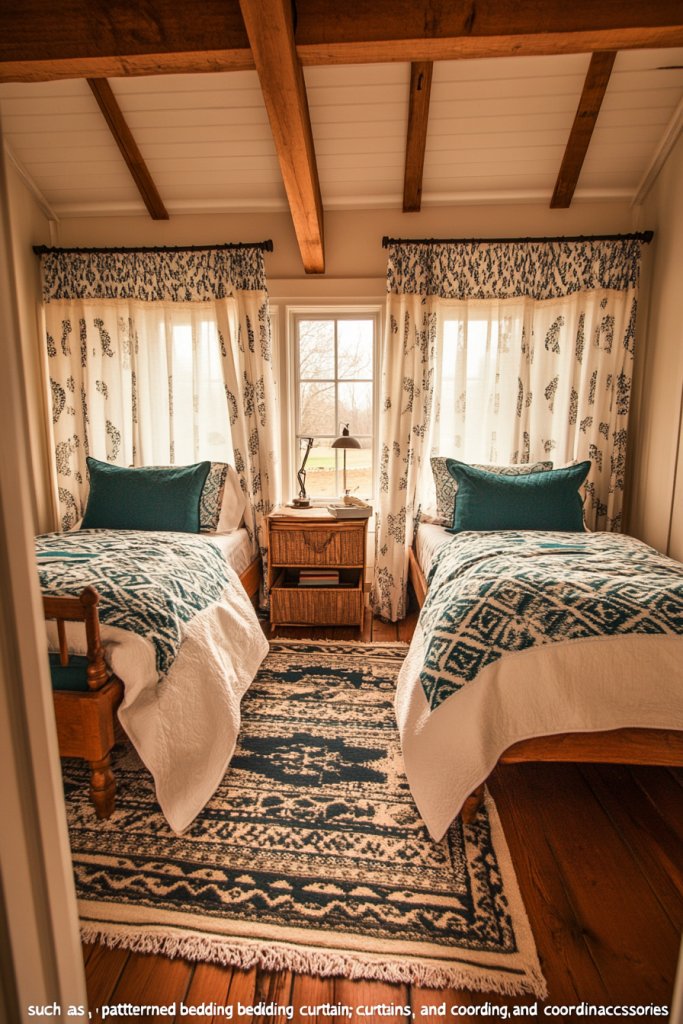
A chaotic mix of colors, patterns, and styles can make a small shared bedroom feel disjointed and overwhelming. Kids want a space that feels cohesive but also allows for their personalities to shine through. Wouldn’t it be awesome if you could create harmony without sacrificing individuality?
Imagine a room with a unifying color palette—like shades of blue and gray—used across bedding, curtains, and accessories. Within that framework, each sibling adds their personal touch with different patterns, plush toys, or small decor items that don’t clash. The room feels balanced and harmonious, yet each kid’s personality is still visible. The overall look is polished and inviting, a perfect blend of unity and diversity.
Choose a core color scheme or theme—like nautical, botanical, or geometric—and let each sibling select their own accents. Mix and match patterns, textures, and decorative elements within the theme for variety. Use neutral or coordinating tones for larger pieces and let smaller accessories reflect personal tastes. Seasonal or mood-based updates can refresh the room without disrupting the overall harmony.
Start with a common color palette for major elements like bedding and curtains. Allow each sibling to choose decorative pillows, rugs, or wall decals that complement the theme. Use a consistent style—like modern or rustic—to tie everything together. Incorporate versatile furniture that can adapt to different tastes, and keep the room clutter-free with organized storage. Regularly review and update accessories to keep the space lively.
Encourage kids to add personal touches—like DIY crafts, framed photos, or themed accessories—within the overall theme. Use matching or coordinating storage solutions to avoid visual chaos. Rotate or swap out decor seasonally, maintaining the balance between cohesion and individuality. Celebrate their unique styles within the shared space.
A thoughtfully themed room fosters a sense of belonging and pride. It teaches kids about design balance and respecting shared spaces. When their personal touches fit within a broader scheme, they feel valued and understood. Creating harmony in a small room is achievable—and it makes everyone happier.
Conclusion
These small shared bedroom ideas showcase a wide range of solutions, from smart organization tricks to stylish design tips, all aimed at making tiny spaces work beautifully. Implementing even a few of these ideas can turn a cramped room into a well-organized, inviting retreat where siblings can feel at home. Don’t hesitate to try these creative approaches in your own space—your perfect sibling sanctuary is within reach. Embrace the challenge and transform your small bedroom into a harmonious haven that everyone will love!
Leave a Reply